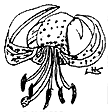Greenacres Links
Landscaping Resources
- Weedlaws
- Toolkit
- Native Vegetation Enhancement
- Wild Ones Handbook
- Homeowners' Resources
- Landscaping Naturally (video)
Remember, we will not post any information intended to directly benefit for-profit enterprises
 Green
Landscaping: Greenacres
Green
Landscaping: Greenacres
Wild Ones Handbook
THE LANDSCAPE THAT WAS, IS, WILL BE
- Prairie Plants Evolved To A Harsh Climate
- Forest Cathedrals
- The Influence of Effluence: Wetter Is Better
- Today's Lawns
- The English Burgher Lawn Aesthetic
- Can Lawns Kill?
- On The Edge of A Sustainable Landscape
|
"We need the tonic of wilderness, to wade sometimes in
marshes where the bittern and the meadow hen lurk, and hear the
booming of the snipe." -
Henry David |
by Pat Armstrong, Prairie Sun Consultants
Loren Eiseley once said, "If there is magic in this world, it is to be found in water." Water sparkles and ripples, gurgles and splashes, trickles and thunders. It can excite like drums in a marching band or sooth like a mother's heartbeat. It can churn with fury or be as still as a mirror.
As long ago as 600 million years past, the Cambrian sea contained every animal phyla except the vertebrates. Amphibian mating choruses were the primeval voices heard on our young Earth when animals crawled out of Devonian swamps 325 million years ago. Water makes our planet unique in the solar system and makes life, as we know it, possible.
When the glaciers covering most of North America melted away some 10,000 to 20,000 years ago, they left a barren landscape. They dropped their ice chunk pothole ponds and superimposed their meltwater rivers on top of this newborn land to let the waters find their own way and create their own drainage patterns. Thus, we were blessed with millions of wetlands: ponds, lakes, rivers, creeks, intermittent streams, sloughs, marshes, sedge meadows, shrub carrs, swamps, floodplains, bogs, fens, springs.
All of these places teem with life. Walk around any natural body of water. Blackbirds "conk-a-ree" in the cattails, shorbirds footprint the mudflats with sanskrit, frogs squawk and leap in ahead of you, whirligig beetles spin in dizzy circles, their double eyes seeing both above and below the water's surface, a beaver disappears with a slap of the tail, dragonflies patrol on gossamer wings, waterfowl carve Vs in the water.
Hidden under the surface, uncountable algae and diatoms, plankton and copepods feed the burgeoning billions of invertebrates. Insect larva and naiads scuba dive, carrying water bubbles or breathing through snorkels. Two-inch salamander tadpoles with their scarf-like gills are caught and sucked dry by the ice-tong jaws of one-inch water tigers or dragonfly naiads. Two-inch water bugs can suck a four-inch adult frog dry.
Boatmen and back swimmer beatles row their long legs looking down or up to find their prey. Water spiders build bubble nests to house their young. Caddis fly larva construct their cases from plant debris or grains of sand, and some catch prey by casting sticky nets.
To be small and live in a pond is the most dangerous thing in the world. One must be very quick and clever to live long enough to reproduce. And reproduction is a megabusiness in the pond. A female American toad can lay 4,000 to 8,000 eggs in double strings; the bullfrog 10,000 to 20,000 in a mass that covers five square feet. Bluegill females can lay up to 67,000 eggs.
Although water is a fairly stable growth medium (it is much slower to change temperature than air or soil), its size, depth and rate of flow affect waves, currents, temperature gradients and light penetration. Different plants and animals are adapted to life in fast or slow currents, deep or shallow water, rocky, sandy or muddy bottoms, and various amounts of light, oxygen or anaerobic conditions.
Some aquatic plants cast their pollen on the surface to float to waiting flowers. Many have swollen stems that trap air to help the underwater parts 'breathe.' And most have large buoyant tubers or seeds that float away to lodge elsewhere and propagate the species.
Even the very muck on the bottom is marvelous, for in it dwell reducing bacteria so necessary in the cycle of life. All living things (except for a few kinds of bacteria and fungi) breathe oxygen and use it to burn (oxidize) their food, producing energy to live and grow, thus more and more substances are changed to their oxidized form. The reducing bacteria in mud live by changing all those oxidized substances back into their reduced state.
 As May T. Watts canoed from open water to a pond shore she
described the sounds of her paddle as drip, splatter, slide, rustle as
it encountered dark water filled with microscopic plankton graduating
to a 10- to 5-foot-deep submergent zone of flaccid water weeds, then
to a 5- to 2-foot-deep area of waxy-leaved, floating lily pads
followed by a 2-foot- to 6-inch-deep area of stiff, emergent cattails
and bull rushes.
As May T. Watts canoed from open water to a pond shore she
described the sounds of her paddle as drip, splatter, slide, rustle as
it encountered dark water filled with microscopic plankton graduating
to a 10- to 5-foot-deep submergent zone of flaccid water weeds, then
to a 5- to 2-foot-deep area of waxy-leaved, floating lily pads
followed by a 2-foot- to 6-inch-deep area of stiff, emergent cattails
and bull rushes.
Wetlands are truly awesome. So instead of fretting over that big puddle or wet ditch, look to Nature. Find the plants adapted to wetlands and create a 'sump pump garden,' a mudflat, a marsh or trickling stream and watch the wildlife teem to your yard.
![[logo] US EPA](../gif/logo_epaseal.gif)